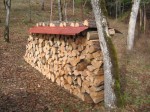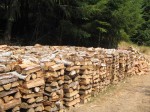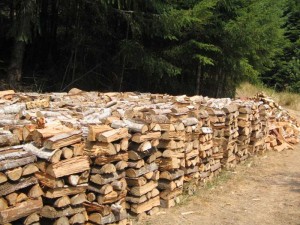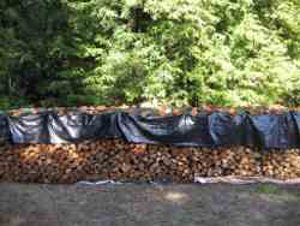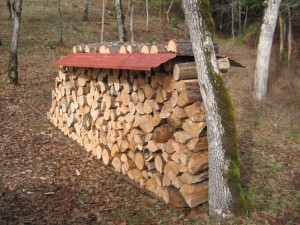 If you don’t have a shed or other structure to store your firewood under to keep it dry, a simple way to keep your firewood dry is to cover it with metal roofing, sometimes called tin roofing.
If you don’t have a shed or other structure to store your firewood under to keep it dry, a simple way to keep your firewood dry is to cover it with metal roofing, sometimes called tin roofing.
One of the most common ways to cover wood is with plastic sheets or a tarp. I have covered firewood with plastic for a long time, but I get tired of pulling the plastic off and on all the time. It always gets holes in it, and it always gets pools of water that collect in the low spots, which gets everything wet when I pull it off.
And tarps, I really don’t like those things. They leak after a while, and then they start to shred into those little strips that get everywhere. They eventually make a mess after they start to degrade and there will be little bits of blue or whatever color pieces all over.
If your firewood is stacked, a piece of metal roofing can be a great way to cover it. If your wood is cut to standard 16″ long pieces, a two foot wide piece of metal roofing on top of the stack will have enough overhang to keep the stack nice and dry. Unless of course it’s raining sideways. But if the wind is blowing that hard, it may also rip a tarp or plastic off anyway.
Both plastic sheets and tarps can inhibit drying of wood since they can trap moisture in. But with metal roofing, there is plenty of air flow all around the wood to keep it dry.
Metal roofing is best used with one long single stack of wood. If you want multiple stacks side by side, you will probably want to space them apart so there is enough room so that the overhangs do not touch. If you want to interlock the roofing over multiple closer stacks side by side, that is another article for another day.
If the stack is longer than the roofing, you can overlap the ends of multiple pieces. It’s best if the roofing can slope a little and the piece on the uphill side can be on top of the down slope piece so the water will run from the uphill piece onto the downhill piece instead of under it and onto the wood.
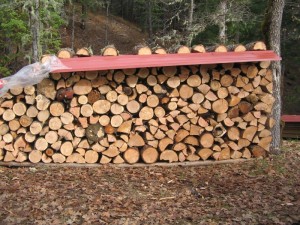 You will of course have to weigh the roofing down so the wind won’t blow it off. It’s just a matter of finding something to place on top that is heavy enough to hold it down. You could also tie it down somehow. I usually just place some pieces of firewood on top. It will get wet, but you can burn those pieces next year.
You will of course have to weigh the roofing down so the wind won’t blow it off. It’s just a matter of finding something to place on top that is heavy enough to hold it down. You could also tie it down somehow. I usually just place some pieces of firewood on top. It will get wet, but you can burn those pieces next year.
Unlike tarps and plastic, metal roofing can last for decades, and you won’t have to buy new ones every year as with plastic. And with any sheet metal, always be careful, the edges and especially the corners can be sharp.
